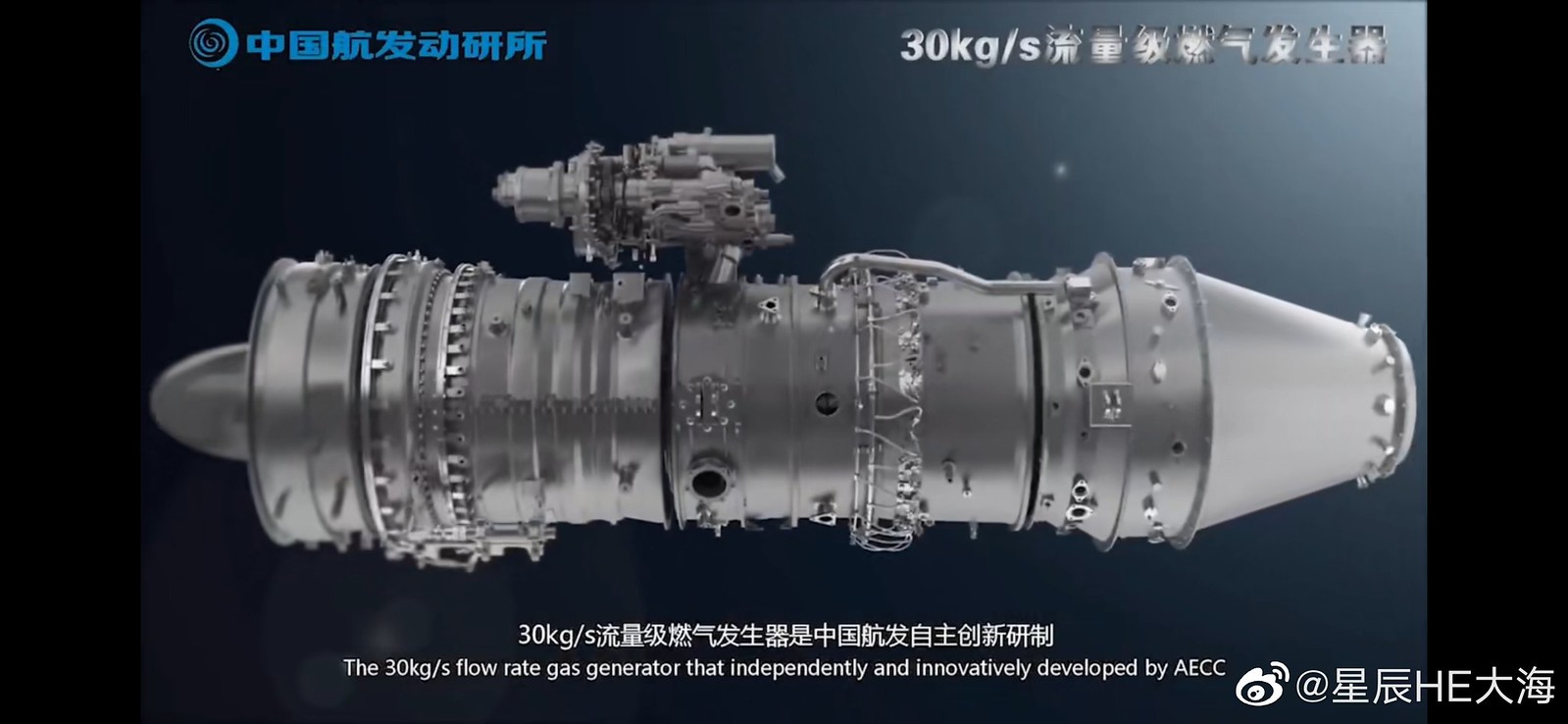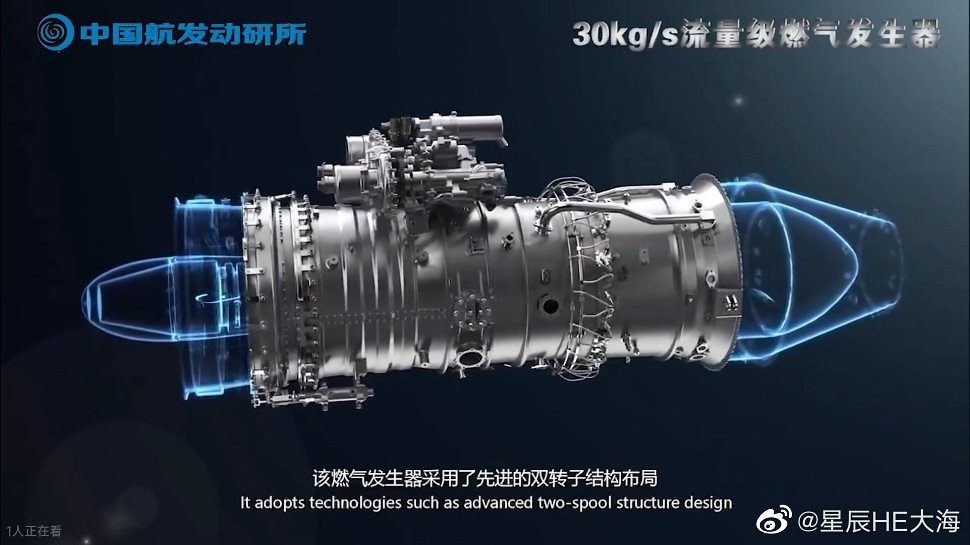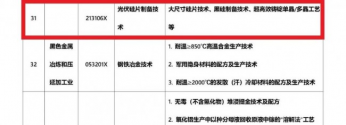Yes, but onboard a Y-20, not yet C919.Was the CJ1000 test-flighted?
You are using an out of date browser. It may not display this or other websites correctly.
You should upgrade or use an alternative browser.
You should upgrade or use an alternative browser.
Chinese Engine Development
- Thread starter jackbh
- Start date
Yes, but onboard a Y-20, not yet C919.
Why the Y-20 and not the IL-76 testbed? Or has it already done with the IL-76 and is not being put on a less specialized aircraft for next phase testing?
Or has a specialzed Y-20 replaced the Il-76 as engine testbed?
by78
General
Screen grabs from a promo video on the 30kg/s flow-rate core from AECC.





Another image of the 30kg/s flow-rate core.
30kg/s流量级燃气发生器是中国航发自主创新的标志性成果之一。该燃气发生器性能达到国际先进水平,通过匹配设计动力涡轮、螺旋桨或桨扇,可发展大功率涡轴、涡桨、桨扇发动机以及地面燃机...
The 30kg/s flow-rate cire is one of the landmark achievements of AECC. The performance of the core has reached the international advanced level. From this core, high-powered turboshaft, turboprop, propfan, and turbine generators can be developed.
nope. this is the biggest misconception regarding CJ-1000 engine components. parts from MTU/RR/Avio are nothing but just a false information. initially COMAC were planning to do this. but plan didn't go through.
i have cleared many times.
all major components are Chinese made. i promised myself that, i shall not disclose the supplier names coz of sensitivity. but this Chinese firm is well-known so i m posting this.
Wuxi Turbine have design the high and low-pressure compressor blades of CJ-1000/CJ-2000.
Wuxi have developed compressor blades of LEAP series (this engine is dominant in 150-seat single-aisle airliners such as A320, Boeing 737 and C919), CFM56 series, CF34, CF6, PP20, LMS100 and LM9000 for Safran and GM, covering more than 50 stages of blades. As of the end of 2020, they have delivered more than one million compressor blades to Safran and GE. 2/3 of entire LEAP engines low pressure compressor blades made by Wuxi.
my old post
I don't know where/when the idea of MTU/RR/Avio participating in CJ-1000 program got started, but it's been circulating for a while now and I certainly have never seen any official confirmation or denial of it. So at this point I'm not sure about it either way.
Here is a report that might indirectly be helpful to figure out the answer.
The most relevant part:
王鹏:GE的发动机有很多零件在中国做。
出口限制最严格的是热端部件,就是高压涡轮,高压涡轮的叶片不在中国做,但高压涡轮盘是在中国做的。高压涡轮罩环,我们过去研究过,是可以在中国做的,但最后这个没拿过来,是因为经济问题,不是出口限制问题。燃烧室不能在中国做,但燃烧室的头部已经在中国做了,发动机从头到尾的机匣都是在中国做的。发动机还有非常多的转子,转子的盘都是在中国做的。
轴承有特殊供应商,这个供应商是否在中国做我没有去仔细调查过。发动机有两根轴,一个是高压转子的轴,我们是在中国做的;低压转子的轴没有在中国做,是因为中国现在的技术不行,我们在开发,但是还没有开发出来非常好的合格产品,所以没有在中国做。还有发动机叶片,我们的高压涡轮叶片不能在中国做,这是出口限制的要求。其他叶片没有在中国做,不是因为出口限制,是因为中国做得不经济。低压涡轮的叶片,我们合作伙伴已经在中国做了。
所以,你可以看到,一台发动机不在中国做的东西太有限了,80%-90%都在中国做。你说中国发动机做不出来是制造技术问题,纯粹是扯淡。这不是问题,即使高压涡轮叶片不在中国做,但高压涡轮打孔技术是我们在中国开发出来的,很多东西中国人是可以做的。
Basically, it's an interview with the Engineering General Manager of GE Aircraft Engine China, Mr. Wang Peng. In the section above, he says GEAE has a lot of Chinese suppliers and many aircraft engine components are made in China (for GEAE). He says that export controls on related aircraft engine technologies do exist. But in reality it is more myth than limitation, because very limited amount of parts and components are not allowed to be made in China with the strictest export control on the hot section of the engine, namely high-pressure turbine and combustion chamber. In fact, even some components of HP turbine or combustion chamber are allowed to be made in China. Some are already, such as the plate of HP turbine or the head section of the combustion chamber. They have thought about having other components of HP turbine or combustion chamber to be made in China, which they didn't end up doing not because of export control but because cost issue. Others examples: shaft of high-pressure rotor are made in China, but low-pressure rotor shaft are not because Chinese technology is still not there yet.
The bottom line is that 80-90% of the components are allowed to be made in China and a lot of them are.
My takeaways from the interview is that China can and has built a lot of components for GEAE (and other foreign engine makers). The real gaps are likely in the most sensitive and difficult sections of the aircraft engine, namely high-pressure turbine and combustion chamber. But here China is not exactly starting from scratch. It can certainly leverage its experience and technologies developed for the military aircraft engine. Based on this reasoning, it's possible that CJ-1000/CJ-2000 are entirely being developed by China, although this is not direct, nor even indirect evidence that this is true. We'll still have to get official confirmation one way or another.
I don't know where/when the idea of MTU/RR/Avio participating in CJ-1000 program got started, but it's been circulating for a while now and I certainly have never seen any official confirmation or denial of it.
Aviationweek:
RR is likely a result of confusion with fellow British company GKN, who are precisely the non-Chinese manufacturers of the CJ-1000 LP shaft, IIRC.
broadsword
Brigadier
Aviationweek:
RR is likely a result of confusion with fellow British company GKN, who are precisely the non-Chinese manufacturers of the CJ-1000 LP shaft, IIRC.
That was from 2011. RR has been unusually quiet about that.
Think the idea started all the way back in 2010 or 2012 when the initial project plan for the CJ-1000 was first announced. Then the CJ-1000 disappeared for a while and once it came back in the picture it seemed to have become a different project.I don't know where/when the idea of MTU/RR/Avio participating in CJ-1000 program got started, but it's been circulating for a while now and I certainly have never seen any official confirmation or denial of it. So at this point I'm not sure about it either way.
Here is a report that might indirectly be helpful to figure out the answer.
The most relevant part:
Basically, it's an interview with the Engineering General Manager of GE Aircraft Engine China, Mr. Wang Peng. In the section above, he says GEAE has a lot of Chinese suppliers and many aircraft engine components are made in China (for GEAE). He says that export controls on related aircraft engine technologies do exist. But in reality it is more myth than limitation, because very limited amount of parts and components are not allowed to be made in China with the strictest export control on the hot section of the engine, namely high-pressure turbine and combustion chamber. In fact, even some components of HP turbine or combustion chamber are allowed to be made in China. Some are already, such as the plate of HP turbine or the head section of the combustion chamber. They have thought about having other components of HP turbine or combustion chamber to be made in China, which they didn't end up doing not because of export control but because cost issue. Others examples: shaft of high-pressure rotor are made in China, but low-pressure rotor shaft are not because Chinese technology is still not there yet.
The bottom line is that 80-90% of the components are allowed to be made in China and a lot of them are.
My takeaways from the interview is that China can and has built a lot of components for GEAE (and other foreign engine makers). The real gaps are likely in the most sensitive and difficult sections of the aircraft engine, namely high-pressure turbine and combustion chamber. But here China is not exactly starting from scratch. It can certainly leverage its experience and technologies developed for the military aircraft engine. Based on this reasoning, it's possible that CJ-1000/CJ-2000 are entirely being developed by China, although this is not direct, nor even indirect evidence that this is true. We'll still have to get official confirmation one way or another.
by78
General
Another Chinese New Year poster from AECC.

AES100发动机是中国航发自主创新研制、具有国际竞争力和完全自主知识产权的1000千瓦级先进民用涡轴发动机,可为5~6吨级双发直升机和3~4吨级单发直升机提供动力。在AES100技术基础上派生发展的“家族”成员——AEP100涡桨发动机、AEF100涡扇发动机,综合性能均达到国际先进水平,可以为公务机、通用飞机以及中高空无人机提供动力。
The AES100 engine is a 1000-kW advanced, internationally competitive turboshaft engine independently developed by AECC. It can provide power for 5- to 6-ton twin-engine helicopters and 3- to 4-ton single-engine helicopters. AES100 has been further developed into AEP100 turboprop and AEF100 turbofan, which are intended to power business jets, general-purpose aircraft, and mid- to high-altitude drones.

The illustration is CGI, but apparently the message is real.
According to this guy, the CJ1000A engine completed its first flight inspection test on January 6, 2023, and the engine mounting test was completed on the 9th. Looks like CJ1000A is getting ever closer to C919...
Verfication and confirmation needed.
According to the sources, I don't think CJ-1000 has been tested on the flight. What this news said is the new aero-based engine test platform made its maiden flight and the engine mounting test. It's a new platform, so it's essential to test if all the systems and functions are good in the sky. So, why mount a brand-new engine on its maiden flight? After the test platform is confirmed to be perfect, then it will enter service and its first customer will be CJ-1000. What we will see then is "the new aero-based engine test platform finished its first test mission."Was the CJ1000 test-flighted?

